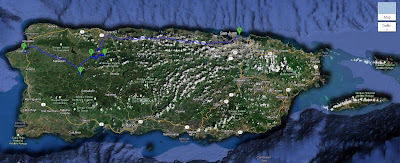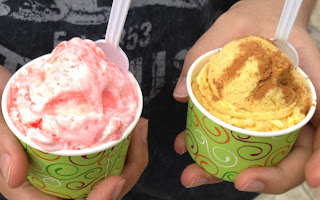Hello All,
As promised, "Let's Travel" series continues with the famous Arecibo Observatory. Haven't heard? Maybe you will remember it from the James Bond movie "Golden Eye".

Right after our visit to Camuy River Cave Park (the post is
here) we headed to the
Observatorio de Arecibo in Arecibo city.
It is a short drive between these two attractions, 10 miles (or 30 mins) to be precise.
This place is the home of the World's largest and most sensitive radio-telescope.
It is not only an attraction, but also an active scientific facility where radio-scientist from all around the World can schedule to use it for their research.

Once you pass the security gate, you will drive up to a parking lot. After parking your car, you will climb up a little bit to reach the observatory.
Starting from this point, you will start seeing warnings about turning off your wireless device, cell phone, etc. I think it's wiser to leave them somewhere safe in your car/hotel and just keep the camera and wallet with you.
The walk from parking lot to the observatory entrance is really nice with the planetary information plates along the road like this one on the left (this was for our beloved planet Earth).
There is a snacks shop midway where you can stop by on the way back and get a cup of coffee. We wouldn't recommend their pina colada, it was bland but their coffee was nice.
When we arrived at the ticket booth we were pleasantly surprised by the nice ticket-lady. We asked for two adult tickets and she gave us discounted student ones. Well, special thanks to her. :)
Regular admission fees: 10 USD (adults) and 6 USD (children/students/seniors).

After the ticket booth, there comes the Angel Ramos Foundation Visitor Center. There are exhibitions, informative tools, videos, interactive mini-experiments, and bilingual (Spanish - English) observatory information presentations provided in this center.
These are especially good for school children. There were a lot of children at the time of our visit and it was nice to notice that they were amused by this newly gained knowledge.
When we visited, there was a temporary NASA exhibit with items used in real space missions.
Our suggestion is to first ask when will the next observatory presentation (in your language) take place then try to cover as much of their information tools as possible. They are fun!

The observatory presentation in English was in two parts: The first part included a short movie on the history of the William E. Gordon Telescope and the observatory while the second part was a presentation given by one of the guides in there. Both parts were fine.
After the presentation guides took us to the platform where we can view the telescope and the huge reflector. Guides told us to ask them any question we might have in mind, but when we looked at the telescope and turned back with questions they were all gone, disappeared, vanished. :/

The picture above is showing the telescope secondary reflector (hanging white ball), line feed (long rod next to it), service bridge, one of the three poles holding the telescope up there, and the giant primary reflector on the ground.
Actually, the primary reflector is not really touching the ground. It is made out of thousands of flexible metal pieces elevated from ground.
Below the reflector is full of vegetation, even some of them managed to grow above the reflector plates. Picture on the right is a close up of the reflector.
After you enjoyed the view and appreciated the smart design of the telescope, you can visit the souvenir shop for some treats/gifts. They sell similar stuff to any Marbles (the brain store) or online (like ThinkGeek.com). They don't have many "observatory specific" souvenirs and I found them a bit over-priced. But still you can get some space food as we did and feel like those cool astronauts on a space mission. :-P
This observatory is one of the important places to visit in Puerto Rico. Especially if you are a scientist or have children, you should definitely visit there.
Here is one nice photograph of the whole observatory grounds from the official NAIC website (for more you can visit their photo galleries: http://www2.naic.edu/public/about/photos/photogal.htm)
Hope you enjoyed reading this post.
The next one will be on the famous Halederia Lares.

















